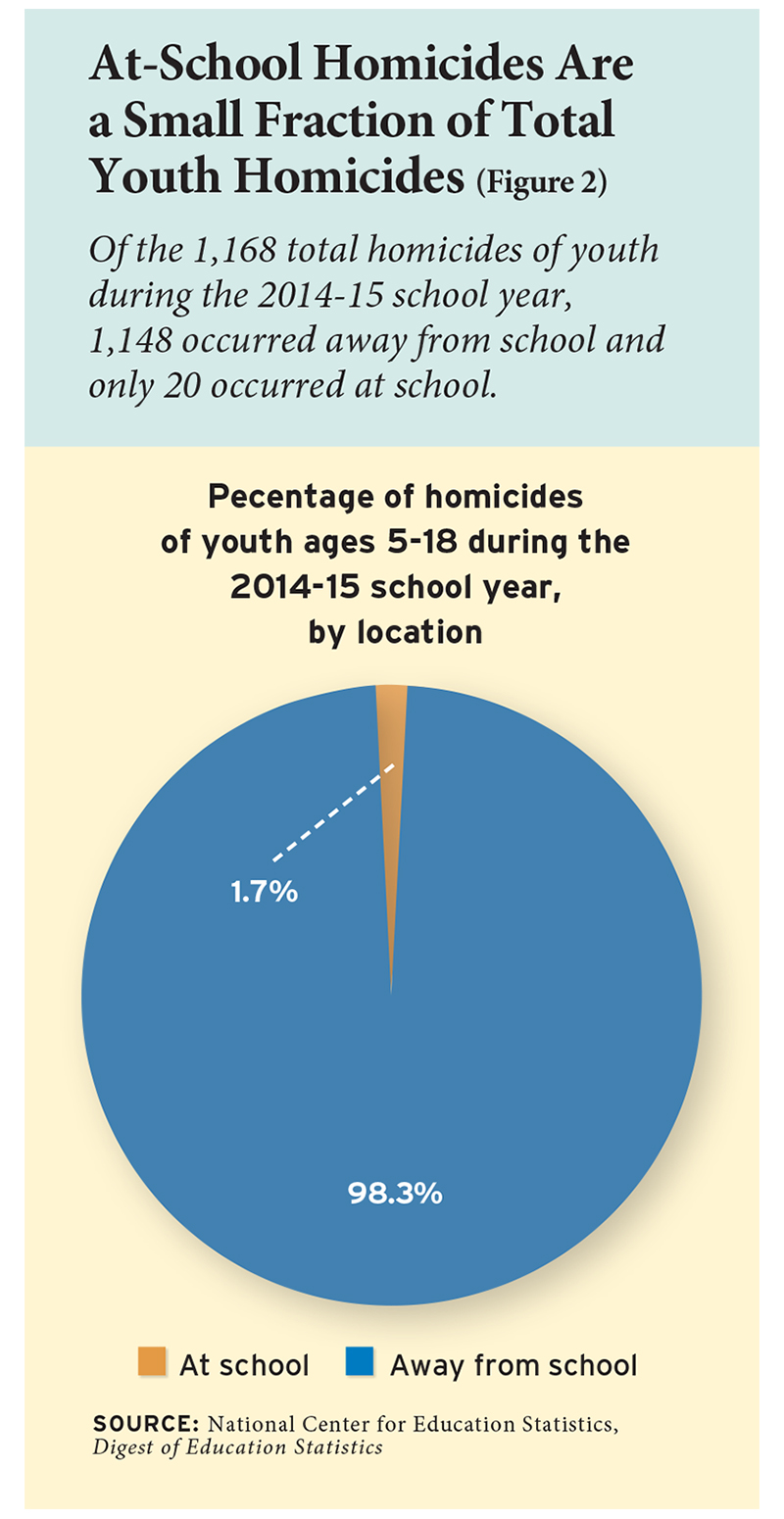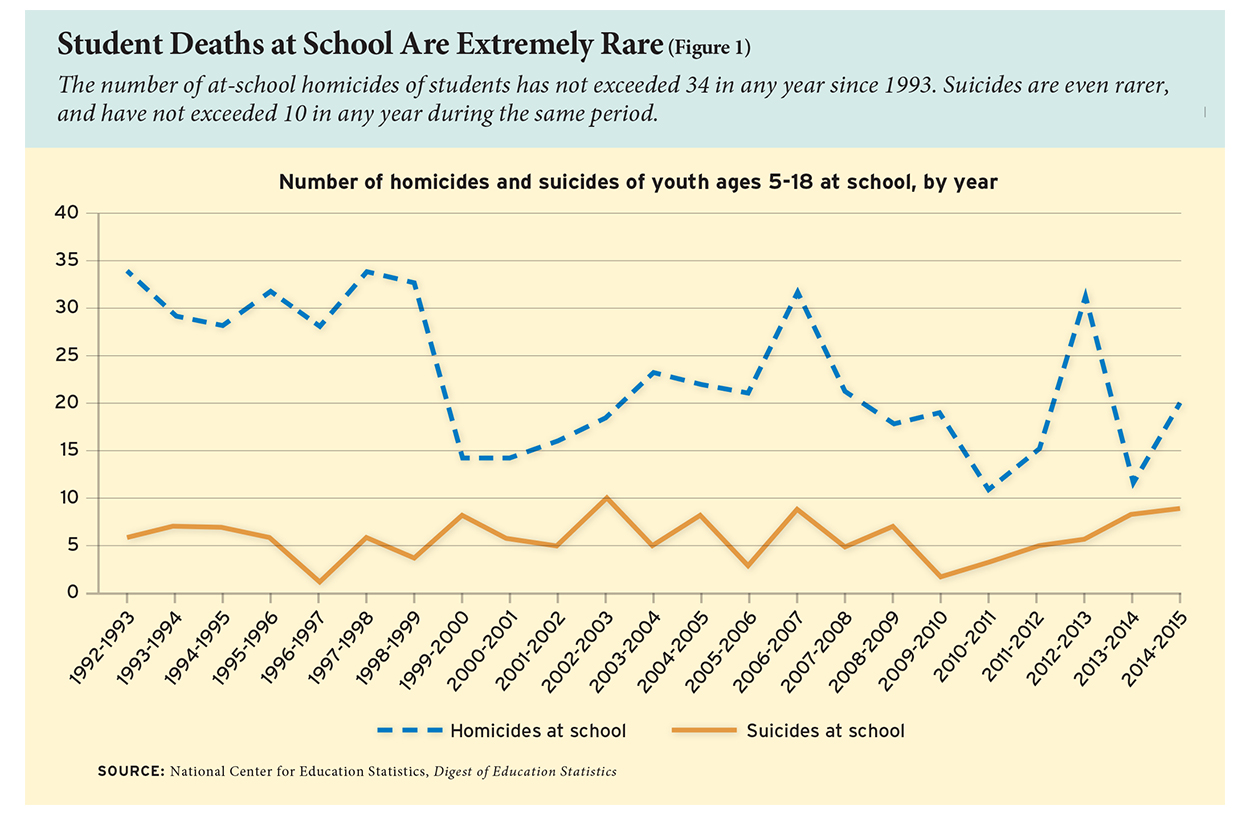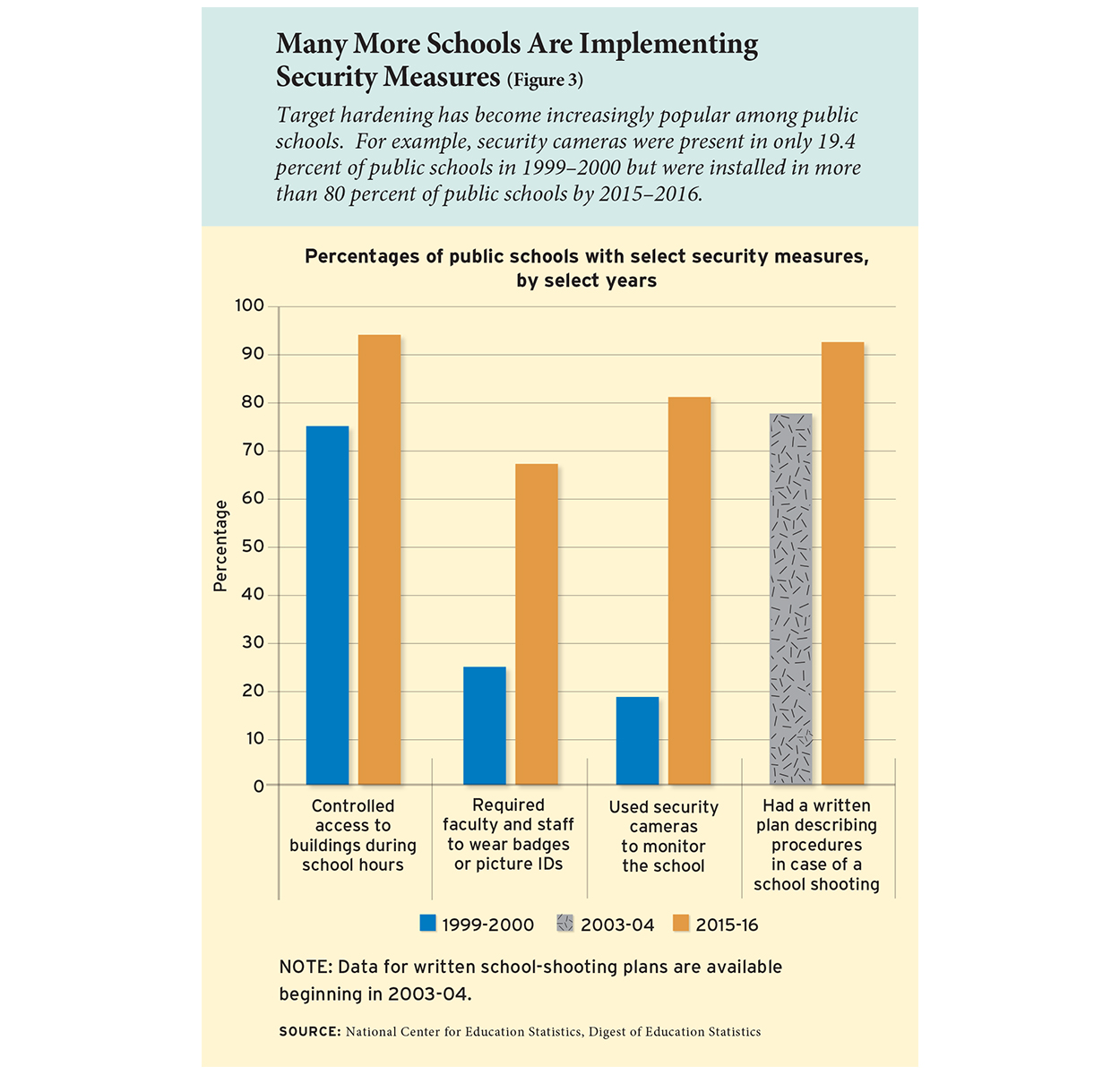 When confronted with the horror of school shootings, we face a dilemma. Naturally, we are deeply troubled by such incidents. The tragedies are so sad and profound—for the families, the schools, the surrounding communities, and the nation as a whole—that it is difficult to ignore these events as statistical white noise. Yet from a rational perspective, we need to recognize that schools, on the whole, are extremely safe places for young people. A joint report from the National Center for Education Statistics and the U.S. Department of Education concluded that children and youth were 87 times more likely to die by murder or suicide outside of school than in it (see Figures 1 and 2).
When confronted with the horror of school shootings, we face a dilemma. Naturally, we are deeply troubled by such incidents. The tragedies are so sad and profound—for the families, the schools, the surrounding communities, and the nation as a whole—that it is difficult to ignore these events as statistical white noise. Yet from a rational perspective, we need to recognize that schools, on the whole, are extremely safe places for young people. A joint report from the National Center for Education Statistics and the U.S. Department of Education concluded that children and youth were 87 times more likely to die by murder or suicide outside of school than in it (see Figures 1 and 2).
How do we weigh our awareness of the overall safe character of U.S. schools against the compelling desire to prevent more school shootings if at all possible? How do we find balance between these two perspectives? In our view, achieving such a balance means taking rational and effective actions to prevent school shootings while also being cautious not to sacrifice educational goals or the school climate for the sake of exaggerated safety concerns.
One approach that risks sacrificing these values is an overemphasis on “target hardening,” which focuses primarily on safety and security technologies. Mass shootings have prompted the target hardening of schools through the expansion of technologies such as metal detectors and surveillance cameras, the deployment of school resource officers (SROs), and the implementation of lockdown procedures and “run-hide-fight” training. These measures are intended to diminish fear and build a collective sense of safety among students and teachers. They also are thought to provide a level of administrative control and a consistent monitoring of student behavior.
In recent decades, these practices have become increasingly popular, particularly in public schools. For instance, the share of public schools employing security professionals rose considerably between 2005–06 and 2015–16, increasing from 42 percent to 57 percent having security staff; from 36 percent to 48 percent having law enforcement officers; and from 32 percent to 42 percent having SROs. Perhaps even more telling, security cameras were present in only 19.4 percent of public schools in 1999–2000 but were installed in more than 80 percent of such schools by 2015–16 (see Figure 3). Likewise, practices such as locking or monitoring doors and using metal detectors have also seen modest increases during these same time periods. Metal detector checks are more common in city schools and in those serving many students of color and low-income students.
While target hardening overall is more widespread in urban public schools, research suggests that parents in suburban schools also embrace the implementation of security measures. Suburban parents readily accept target hardening as a sign that schools are taking violence seriously and are adopting measures to protect the physical and mental well-being of their children.
Regardless of location, school and district leaders are under pressure to adopt target-hardening strategies as a means to protect against violence. Serious incidents, such as school shootings, are highly publicized. The media frequently and intensively cover these events, leaving disturbing images fresh in the minds of parents, who then understandably feel that schools have become unsafe spaces for their children and argue to administrators that more must be done to protect them. Additionally, school communities turn to target hardening to safeguard against potential litigation that could stem from a perception that a school is “unsafe.” Layering a school with various security technologies and providing security training for staff allows administrators and policymakers to point to concrete steps they have taken to safeguard buildings.
In 2018, the high-profile school shootings in Parkland, Florida, and Santa Fe, Texas, prompted political action. In March, President Trump asked secretary of education Betsy DeVos to chair a newly formed Federal Commission on School Safety. The commission released its report in December, recommending a greater focus on target hardening; additional armed and trained staff in schools; and enhanced mental health services, among other measures. As expected, the commission mostly ignored the topic of access to firearms, even the question of age restrictions, which the administration had encouraged the panel to consider. The commission also recommended a reversal of the Obama administration’s guidelines on school discipline, which prohibited schools from meting out student punishments disproportionately by race.
Further political response to school shootings was evident in a number of referenda approved by voters in November 2018, providing funds to enhance school safety and improve mental-health services for students. In Indiana, the Indianapolis Public Schools ($52 million) and the Noblesville School District ($50 million) will use these newly approved funds to augment school-safety features and provide better mental-health support for students. Voters approved a similar ballot referendum in Cook County, Illinois ($69 million), where funds will be used for security upgrades and other improvements to buildings. The safety measures will focus on enhanced security for school entrances, improved lighting, and upgraded security cameras. New Jersey voters also gave the nod to a referendum ($500 million) that included funding for safety upgrades across K–12 schools, though it is unclear how much of the funding will be dedicated to school security. Finally, in Miami-Dade County ($232 million per year over five years), voters passed a measure aimed at teacher raises and hiring more school resource officers. Each year, 10 to 20 percent of the money will be allocated for schools to boost safety and security features.
Essential Questions
 While target hardening is an increasingly prevalent response to school shootings, it brings up a number of questions and concerns. First, what kind of impacts do security practices and technologies have on the learning environment? What messages do such practices send to students about their schools? To be sure, some students might feel safer and calmer in hardened environments, but it is equally plausible that intensive security procedures send the message that schools are unsafe, fearful places, thus adding an element of stress to the learning environment. Indeed, some evidence suggests that security technology such as surveillance cameras and metal detectors sends different messages, depending on the student population. For example, research indicates that African American students perceive school security practices as being implemented less fairly than their white peers do. The question, then, of how to get the messaging right when it comes to security practices, if it can be “right,” deserves serious consideration.
While target hardening is an increasingly prevalent response to school shootings, it brings up a number of questions and concerns. First, what kind of impacts do security practices and technologies have on the learning environment? What messages do such practices send to students about their schools? To be sure, some students might feel safer and calmer in hardened environments, but it is equally plausible that intensive security procedures send the message that schools are unsafe, fearful places, thus adding an element of stress to the learning environment. Indeed, some evidence suggests that security technology such as surveillance cameras and metal detectors sends different messages, depending on the student population. For example, research indicates that African American students perceive school security practices as being implemented less fairly than their white peers do. The question, then, of how to get the messaging right when it comes to security practices, if it can be “right,” deserves serious consideration.
Another important question is: to what extent and in what ways do teachers and other school personnel reinterpret their roles and responsibilities in a target-hardened school? Some security practices—the use of armed officers and metal detectors, for example—set the stage for a different way of thinking about students. A hardened environment frames children and youth not as learners but as potential threats to be policed, controlled, and, in some sense, feared. This is particularly true when it comes to the ultimate target-hardening strategy: arming teachers themselves. How might armed teachers think differently about their roles and relationships with students?
Finally, we need to think more about the array of ethical questions that security practices present. To what extent, for example, should student expression be monitored? Should schools hire private companies to track students’ threatening statements and other activity on social media? And to what extent do we owe students a degree of privacy? These ethical questions expose possible conflict between security practices and the civic goals of schools. We want students to learn how to act autonomously and responsibly. Is this educational aim compatible, though, with an environment where we closely monitor and police every student statement and action? Or should we try instead to construct spaces for student freedom, space for students to practice acting with moral responsibility and according to their own reasons?
We do not have all the answers to any of these questions, but we do have a body of research indicating that some school security measures are correlated with undesirable, and sometimes harmful, outcomes for students, staff, and the school environment. It’s important to emphasize the correlational nature of this research and note that it does not demonstrate a causal relationship, but the results do raise red flags about the target-hardening approach. For instance, researchers have found that students and staff in schools that employ various security measures report experiencing higher levels of fear. Students say they feel less safe in schools with visible security measures, a finding that would indicate a potential challenge to the learning environment. Researchers have noted similar findings for schools that employ SROs: students report a greater sense of fear over their safety; a more disruptive or disordered school environment; and a greater likelihood of being arrested.
The possibility that security technology adversely affects school environments is most troublesome in urban schools, where school security technologies are adopted with greater frequency. The zero-tolerance discipline policies that arose in the 1990s, partly in response to the school shootings of that decade, led to widespread use of suspension and expulsion—a phenomenon that many researchers believe has had a demonstrably negative impact, particularly on students of color.
The unfavorable outcomes associated with target hardening are further correlated with lower levels of community involvement and a weaker sense of trust within schools. Studies have found that parents are less likely to become formally involved (for instance, by volunteering in the classroom or chaperoning field trips) in schools that incorporate security technologies. Student participation in extracurricular activities is also lower within schools utilizing security measures. Further, the use of target-hardening strategies is associated with less student trust in teachers and administrators. The troubling connections also extend to measures of student academic success. Visible school-security technologies, particularly in high schools in lower-income communities, are associated with decreased educational attainment and aspirations.
As noted above, there is no evidence that the presence of security technologies causes a negative school environment. But even in schools where the undesirable environment precedes and prompts the adoption of the security practices, we cannot be sure that the target hardening is not making the school climate worse.
These red flags would be less worrisome, of course, if we could point to demonstrable gains in student safety through the target-hardening approach, but few studies have addressed this connection. Randy Borum of the University of South Florida and his colleagues, in a systematic review of the literature, conclude, “Using surveillance systems, metal detectors, and access control devices, school administrators have made numerous attempts to enhance safety, although there is little empirical research available to evaluate these practices.”
Sensible Measures
What, then, is a sensible approach to school safety and security? The prevention of school shootings is not a complete mystery: we have many examples of school shootings that have been averted. One commonality among many of them is that students and families communicated with the school about their security concerns; they felt they could approach the school if they suspected a student was troubled and threatening, and the school would respond appropriately. In Ripon, Wisconsin, a student reported to school authorities another student’s intention to shoot eight specific students. In Hilliard, Ohio, a student overheard a classmate discussing detailed plans to execute a school shooting and immediately reported it to the SRO—the plans included a diagram of the attack, a listing of the necessary weapons, and a recruitment plan to draw in other students. In Frederick County, Maryland, a father reported to school authorities that his daughter was planning to attack a school, and authorities later discovered the girl had acquired a shotgun and made detailed plans. In all of these cases, it seems that serious incidents were avoided—by means of open communication between schools, students, parents, and community members.
As school leaders think about how they can harden schools against attack, therefore, they should also consider how they can further develop relationships of trust that allow for this open and honest communication. The greatest benefit of this trust-building approach over target hardening is that its “side effects” are likely to support the educational mission of schools rather than disrupt it. The target-hardening approach sends messages of fear, insecurity, and mistrust, and as we’ve seen, there is some reason to suspect that this has a negative impact on the educational mission. An approach that emphasizes schools as communities that listen, build trust, and provide open channels of communication, in contrast, is likely to benefit the educational mission. Scholars have noted that trust is one of the core elements, not only of safe schools but also of effective schools. Safety and success go hand in hand.
One productive convergence of the trust-building and target-hardening approaches is seen in the use of threat-assessment teams, a promising trend in school security. Threat assessment has been recommended by the FBI, the Secret Service, and the Department of Education. Under this approach, teams of school personnel, law enforcement officers, and members of other relevant professions, such as social workers, systematically assess threatening student behavior to determine the nature and severity of the threat. This screening method differs from “profiling” because it is based on a student’s own threatening behavior, not a generic outline of social background and personality traits. Threat assessment, which is designed to distinguish between serious and non-serious threats, helps authorities avoid both overreacting and under-reacting. Thus, it reduces the need for automatic long-term suspension or expulsion for threatening behavior. The threat-assessment strategy formalizes the communication that should already exist within a good school, using a team-based approach not only to identify threats but also to determine what troubled students might need in terms of help and support. This is a type of security practice that seems to contribute to the educational mission of schools rather than work against it.
Educators should also think about how the school climate and culture contribute to the possibility of school shootings and then work to change those contributing factors. Reading detailed accounts of school shootings provides some clues about what schools could be doing differently. In the early 1990s, the sociologist Katherine Newman led a team of researchers in an exhaustive sociological study of school shootings since 1970. Their report shone a light on the perennial social competition among teens in the school environment, which she termed the “status tournament of adolescence.” Some school practices intensify this competition. Think of the prominence of sports in American schools, with the tryouts, rankings, and sorting that go along with it. Think, too, of the teenage fixation on popularity and the common practice of anointing “kings” and “queens” at proms and homecoming dances. School shooters often report feeling like the losers of these status tournaments, and this disappointment sometimes turns to anger against the school environment, as was apparently so in the shootings at Columbine High School in Colorado (1999), East Carter High School in Kentucky (1993), and Westside Middle School in Arkansas (1998). Instead of fostering competition, schools might look for ways to increase students’ sense of belonging. If the past is any guide, such efforts could help make for safer schools.
We do not mean to imply that target hardening is never the appropriate response to school shootings. In some situations, such practices may indeed be necessary. What is crucial is that schools remain aware of the potential negative impact of such practices and weigh them closely against the educational mission. At the same time, educators should embrace the idea that school safety is first and foremost a matter of school community: an issue of the trust and communication that exists, and of the sense of belonging that schools can foster to counteract the status tournament of adolescence. The practices that work in one school may not work in another. School and community leaders should take a careful look at their own school environment and decide on methods that could create not only a secure setting, but also a caring one. Instead of simply hardening schools against attack, educators should focus on building school environments characterized by mutual trust, active listening, respect for student voices and expression, cooperativeness, and caring relationships with and among students. These measures not only make schools safer, they also make schools better.
Bryan R. Warnick is professor and associate dean in the College of Education and Human Ecology at The Ohio State University. Ryan Kapa is a postdoctoral researcher in the Center on Education and Training for Employment at The Ohio State University.
This article appeared in the Spring 2019 issue of Education Next. Suggested citation format:
Warnick, B.R., and Kapa, R. (2019). Protecting Students From Gun Violence: Does “Target hardening” do more harm than good? Education Next, 19(2), 22-28.




